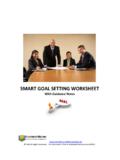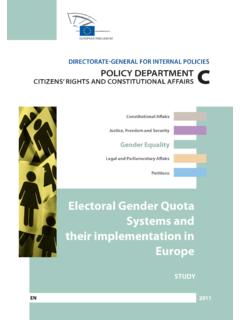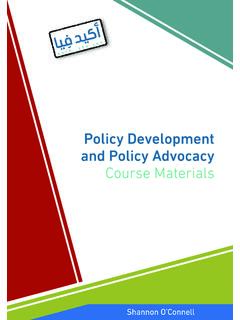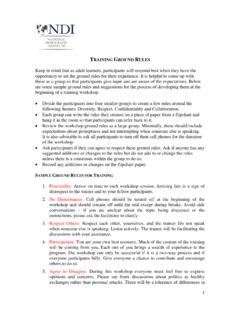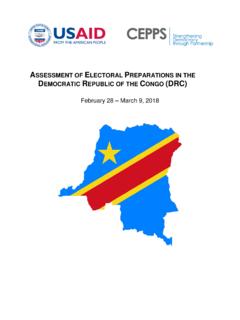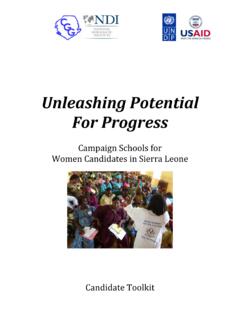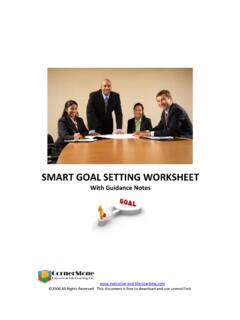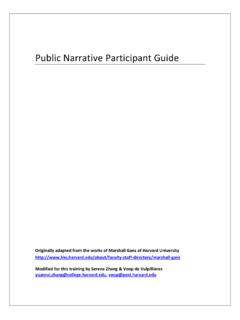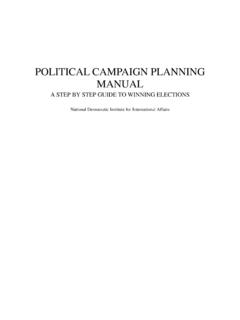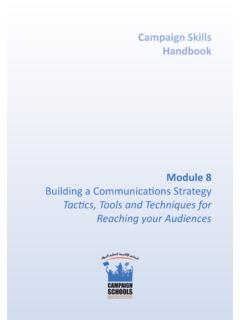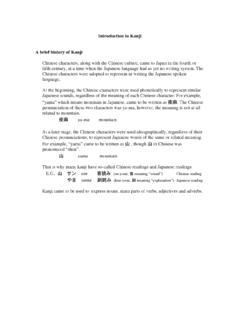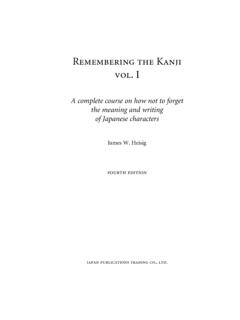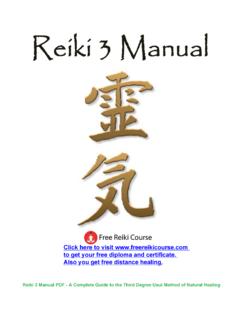Transcription of A Guide to Gender-Analysis Frameworks - ndi.org
1 A Guide to Gender- Analysis Frameworks Candida March, Ines Smyth, and Maitrayee Mukhopadhyay Oxfam First published by Oxfam GB in 1999. Reprinted by Oxfam GB in 2000, 2003, 2005. Oxfam GB 1999. ISBN 085598 4031. A catalogue record for this publication is available from the British Library. All rights reserved. Reproduction, copy, transmission, or translation of any part of this publication may be made only under the following conditions: with the prior written permission of the publisher; or with a licence from the Copyright Licensing Agency Ltd., 90 Tottenham Court Road, London WiP 9HE, UK, or from another national licensing agency; or for quotation in a review of the work; or under the terms set out below. This publication is copyright, but may be reproduced by any method without fee for teaching purposes, but not for resale. Formal permission is required for all such uses, but normally will be granted immediately.
2 For copying in any other circumstances, or for re-use in other publications, or for translation or adaptation, prior written permission must be obtained from the publisher, and a fee may be payable. Available from: Bournemouth English Book Centre, PO Box 1496, Parkstone, Dorset, BH12 3YD, UK. tel: +44 (0)1202 712933; fax: +44 (0)1202 712930; email: USA: Stylus Publishing LLC, PO Box 605, Herndon, VA 20172-0605, USA. tel: +1 (0)703 6611581; fax: +1 (0)703 6611547; email: For details of local agents and representatives in other countries, consult our website: or contact Oxfam Publishing, 274 Banbury Road, Oxford OX2 7DZ, UK. tel: +44 (0)1865 311311; fax: +44 (0)1865 312 600; email: Our website contains a fully searchable database of all our titles, and facilities for secure on-line ordering. Published by Oxfam GB, 274 Banbury Road, Oxford OX2 7DZ, UK. Printed by Iitho and Digital Impressions Ltd, Witney.
3 Oxfam GB is a registered charity, no. 202 918, and is a member of Oxfam International. This book converted to digital file in 2010. Contents Acknowledgements v 1 The context of this book 7. introduction 8. Key concepts 17. Choosing a framework 22. 2 The Gender-Analysis Frameworks and users' commentaries 29. Explaining the chapters 30. Harvard Analytical Framework and People-Oriented Planning 32. Moser Framework 55. Gender Analysis Matrix (GAM) 68. Capacities and Vulnerabilities Analysis Framework 78. Women's Empowerment (Longwe) Framework 92. Social Relations Approach- 102. Bibliography 120. Appendix 123. Notes 131. Index 133. Acknowledgements This book is based on an earlier pack compiled by Candida March for internal Oxfam use, which, in turn, built on the work of Maia Pinto and Sue Smith. The development of the pack was supported and managed by Maitrayee Mukhopadhyay. For the book, Ines Smyth has written an introduction , placing the Frameworks in the wider context of gender and development work.
4 The reason for producing the book (and the earlier pack) is to provide a single volume which discusses the most well-known gender analysis Frameworks for development research and planning, with commentaries from users of each framework. The commentaries are based primarily on the experience of Oxfam staff members throughout the world, and their colleagues and associates in gender training networks and academic establishments. In addition, they owe much to work first presented in Reversed Realitiesby Naila Kabeer, Verso, 1994. In its discussion of the various gender Frameworks and how they are used, the book draws substantially on ideas, and words, from many other publications, including Oxfam's own Gender Training Manual. Oxfam is grateful to all the individuals and organisations whose work appears here for permission to use their material, and wherever possible, the source is acknowledged in the appropriate places in the text.
5 In addition, the sources reappear in the bibliography at the end of the book. We would be glad to hear from anyone whose material has not been fully acknowledged, so that any omissions can be corrected should the book be reprinted. Finally, the book owes much to Elsa Dawson, Judy El Bushra, Sukey Field, Laurie Forcier, Georgia Gill, Karoline Kuprat, Yvonne Kuprat, Margaret Legum, Nazneen Kanji, Caren Levy, Fra von Massow, Debbie Mander, Dorinne Plantenga, Tahmina Rahman, Mohga Kamal Smith, and Caroline Sweetman. The context of this book introduction 8. Key concepts 17. Choosing a framework 22. I introduction Ines Smyth This short Guide to Gender-Analysis tools and gender Frameworks is based on a pack developed in 19 9 6 for the use of Oxfam staff and partners. The book aims to be a stand-alone resource, discussing the methodologies of the best known analytical Frameworks which have been used to integrate gender conside- rations into development initiatives.
6 It gives practical examples of each frame- work, and provides accessible commentaries discussing the Frameworks '. potential uses, advantages, and limitations, as well as recent adaptations. The commentaries draw on a wide range of experience of Oxfam staff, partners, and colleagues in other organisations, who have used the gender Frameworks in various training, planning, and evaluation processes throughout the world. The book is intended to meet the needs of development practitioners, trainers, researchers, and students for an introduction to such gender frame- works; we hope that, in addition, it will be of use to those who are already familiar with the main concepts and methodologies. However, this Guide does not seek to be a comprehensive manual or a rigorous teaching text; for example, it does not cover the wide range of techniques and information contained in the original gender Frameworks . Most importantly, the users'.
7 Commentaries are not exhaustive, nor have they been collated in a 'scientific'. way. They simply capture some experiences of gender and development workers in using the Frameworks , and outline the possibilities and constraints of working with different gender Frameworks in particular contexts. The book is intended as a 'taster', providing readers with a glimpse of the many practical insights that such gender Frameworks can offer. We hope that this will stimulate readers to turn to the texts where the gender Frameworks are set out in more detail. Those who are not in a position to apply the gender Frameworks in direct and immediate ways - managers of development organisations and government agencies, researchers, students, and trainers - can all benefit from the insights that the original texts offer, and from the deep commitment to gender equity in which they are rooted. Before we introduce and discuss the selected gender Frameworks , this introduction intends to locate them in the broader context of integrating gender considerations into development work.
8 We wish to emphasise that using Gender-Analysis Frameworks can encourage a practice of development which has the potential to contribute to the struggle for gender equality and for women's rights. However, such a potential can be realised only if appropriate gender Frameworks are used and applied in a sensitive and skilled manner. Moreover, their use must be based on a political, and personal, commitment to a principle of social justice which includes gender equity. The history of gender concerns in development organisations A concern for gender equality in development is sufficiently well established to be the subject of historical accounts. Such accounts often describe an evolution in development policy and planning from a so-called welfare approach, to one which prioritised equity, then efficiency, and finally to one which espouses women's empowerment as its goal (Moser 1993). Such approaches are also seen to coexist, either as single policies of a particular government or agency, or mixed-and-matched within one organisation, in the hope that they will form a coherent whole (Andersen 1992).
9 Whatever the merit of such accounts, the most important distinction they make is that between two policy perspectives: WID (Women in Development), which aims to include women in development projects in order to make them more efficient, and GAD (Gender and Development), which addresses inequalities in women's and men's social roles in relation to development. The advantages of the shift which has supposedly taken place from one to the other have been amply discussed elsewhere (for example, Elson 1995 and Kabeer 1994), and need not be further described here. The point is that even within GAD, a variety of perspectives coexist (Levy 1996). As a consequence, GAD as a policy and planning approach remains complex, both in terms of language and in terms of the possible practices which it encompasses. Something else appears from the historical accounts of the different inter- pretations of women and gender issues in development.
10 From the earlier debates it was clear that societal attitudes are pervasive: thus they influence the nature of projects intended for women and their ability to achieve their objectives (Buvinic 1984). With the shift from WID to GAD, this realisation came into sharper focus: development bureaucracies and other related organisations were seen to be 'gendered', in terms of their culture, rules and outcomes (Goetz 1995). In patriarchal societies, this means that the organisations' culture, rules, and outcomes are modelled on male values and attitudes. Thus, they are often inimical to women, fail to recognise and reward their contributions to the organisation, and therefore recreate and reproduce the gender hierarchies and inequalities dominant in the wider world. introduction What is 'mainstreaming' gender? Turning one's attention from what development actors do, and what approach they use, to who they are, leads to the call for organisations to 'mainstream'.
